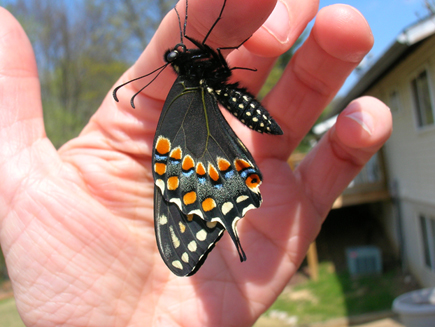Welcome! This blog is mostly about butterfly gardening, but other types of plants and gardens, as well as
other wildlife is blogged about too.
My one Pipevine Swallowtail pupa – from the only Pipevine Swallowtails caterpillars that I’ve ever had – that I took such good care of over the winter – my dog attacked and possibly ate. Killed anyway. It was in the jar shown a couple of posts ago. She’s not my best friend today.
I had a couple of Black Swallowtails who I had pupating over the winter emerge today!
I think it is a bit early for them in this area though – I don’t know if they will do very well. Its been rainy here too.
Here they are in the jar they pupated in:
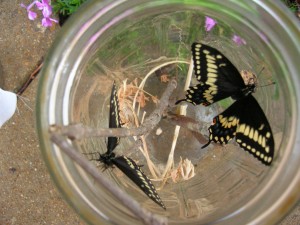
Here’s the first one after I got it out:
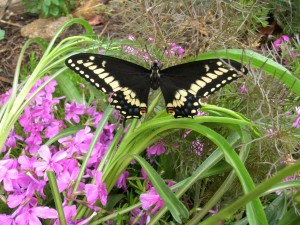
Here they both are:
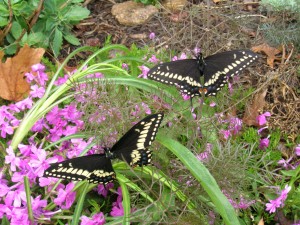
They were very small, which isn’t that unusual for butterflies that started pupating late in the previous season.
Wow! I saw lots of butterflies in my garden this afternoon. At least its a lot for where I live. There were 4 large butterflies flying all close to the same time. Three swallowtails were all out there at the exact time even.
And – the best part – a butterfly I’ve only just previously seen fly through quickly and leave: a Zebra Swallowtail! You might remember that I mentioned seeing Zebra caterpillars recently when we were walking around at Shaw Nature Reserve. We had just gotten back from getting groceries and I went back to close the door and saw it right outside on some purple cone flowers. I ran back in and got the camera, but it wasn’t there. I walked all through the yard in the back and everything and thought for certain it had left – but then I found it! I got few pictures of it that were pretty good, they don’t like to hold their wings still though, so it isn’t easy.
It eventually started nectaring way high up on a white butterfly bush of mine. It seemed to prefer it over the purple ones.
Here it is on some rattlesnake master:
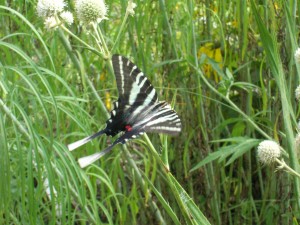
And now on the butterfly bush:
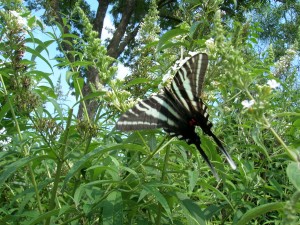
And then while I was still watching the Zebra, a yellow form Tiger Swallowtail and a dark form Tiger Swallowtail flew into my garden and starting nectaring on my plants:
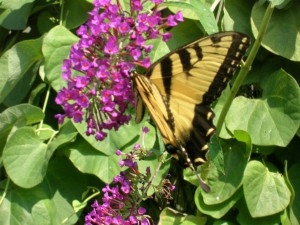
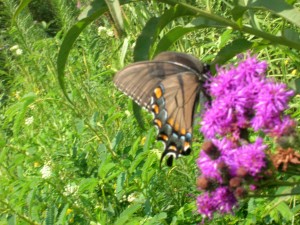
And a little while after that a Monarch stopped by. It first was nectaring on my Iron Weed then resting on some pipevine where I was able to get a good picture of it:
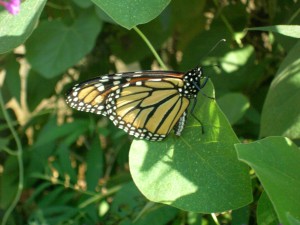
A little later I also saw a Buckeye in my husbands ‘Zen’ garden area:
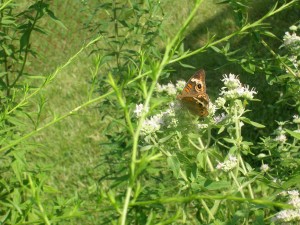
It was awfully hot out there though and I started getting a big overheated and had to come in, last I saw that Zebra Swallowtail was still there. It had to have been out there at least a half an hour. Definitely the longest I’ve ever seen one in my garden!
I posted earlier about some of the caterpillars I had seen on my Golden Alexanders and how I was curious about which species exactly they were.
Here are a couple other pictures – two different caterpillars, both eating Golden Alexander leaves:
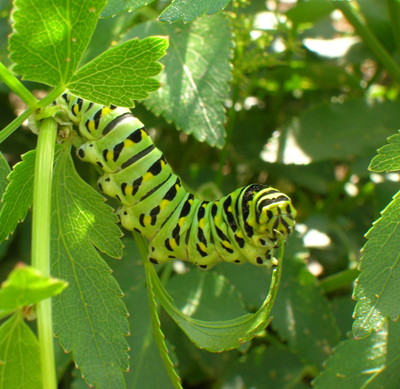
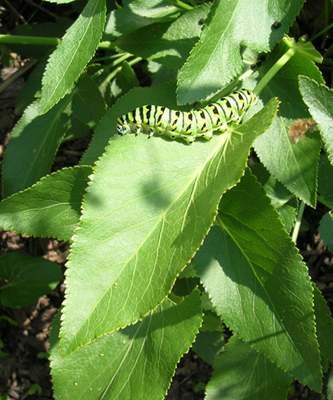
The thing is, the bigger one that had been on the Yellow Pimpernel a couple days before seems to have moved over to the Golden Alexanders. I can’t be certain it was the same one though of course. But the large one was gone and suddenly a second large one appeared on the other plant that I hadn’t noticed before.
So are they Papilio polyxenes or joanae? I have not actually seen eggs on the Golden Alexanders yet, but did see an adult behaving as though she might ovi-deposit (sp?) there. Would only P. jonae lay eggs on Golden Alexanders? Or might P. polyxenes do it too? Or maybe all were laid on the Yellow Pimpernel and moved over to the Golden Alexanders? But why would P. polyxenes be interested in Golden Alexanders? Any insight into this would be appreciated.
(Technorati Tags: butterfly, caterpillar, Black Swallowtail, Papilio joanae, Papilio polyxenes, Taenidia integerrima,)
I found a Black Swallowtail caterpillar on my Golden Alexanders!
My understanding had been that if any Swallowtail in this area were to use Golden Alexanders (Zizia aurea) it would be only the Woodland Swallowtail (Papilio joanae) – but others sources seem to doubt that P. joanae is really a separate species anyway. Up until now I never saw any caterpillars on the plants. I did for the first time recently see an adult looking as though she was interested in laying on them however, but I didn’t find any eggs.
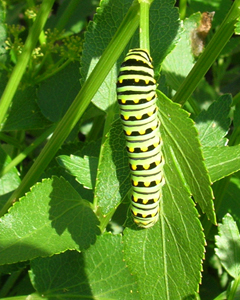
Now, as I was trying to find a truly native host plant for Black Swallowtails, I bought a Yellow Pimpernel (Taenidia integerrima) plant last year for my garden. Earlier this spring I found an egg on it, and later a first instar larvae, which of course I would assume would be a Black Swallowtail (P. polyxenes). I didn’t really keep track of it to see how it was doing – but have been very excited to have found a native host plant for them that they will actually use!
Anyway, on Friday, I looked over at the Yellow Pimpernel plant, which incidently is right next to the Golden Alexanders, and saw two caterpillars on it! The larger of the two was towards the base of the plant and kind of hidden from view:
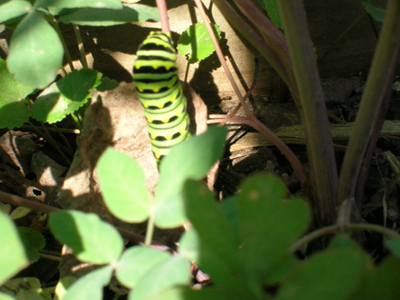
Then, I look up, and towards the top of the plant – on a stem that already had all its leaves eaten off I see another caterpillar! Only this one was in the process of molting. The first pictures I tried to take as it was actually molting were all out of focus. Apparently this camera had a hard time figuring out what to focus on and it doesn’t have a manual focus so there was nothing I could do. I eventually put my hand up behind the caterpillar and then it focused just perfectly! By that time it was done molting but it was still a cool picture – its head is still white and if you look closely you can see the dead skin behind it, mostly behind the stem it is on:
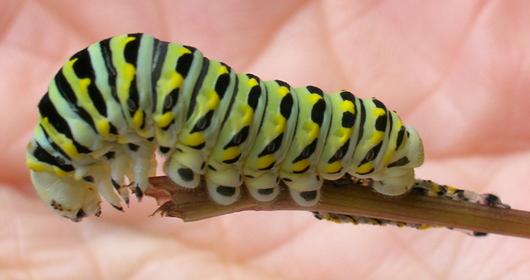
The whole thing left me wondering though – were the caterpillars on the Golden Alexanders P. polyxenes or joanae?
(Technorati Tags: butterfly, caterpillar, Black Swallowtail, Papilio joanae, Papilio polyxenes, Taenidia integerrima,)
Here are a couple of Black Swallowtail caterpillars from the first batch of Black Swallowtail eggs I’ve had this year. They are feeding on fennel.
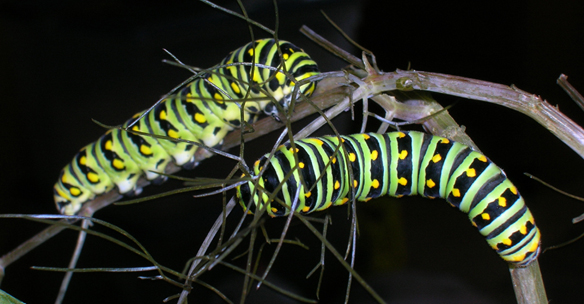
This Spicebush Swallowtail emerged from its chrysalis – but I only had a chance to get one quick picture of it before it flew away!
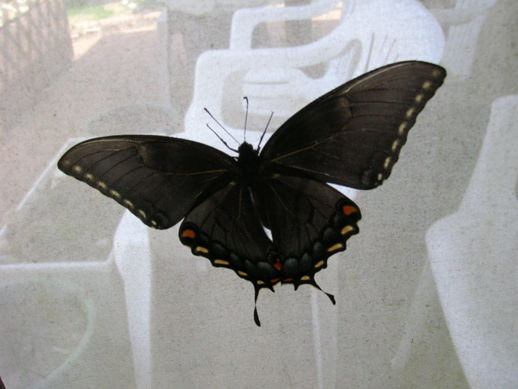
My first Black Swallowtail to emerge from its chrysalis did so today. (Actually it is the only Black Swallowtail I had over wintering.) It was a male and I managed to get a few decent pictures of it – here is one of them – on my hand before it flew off:
